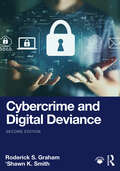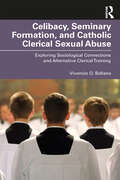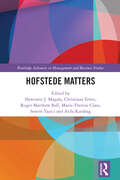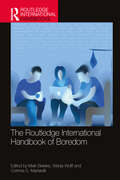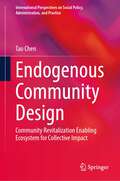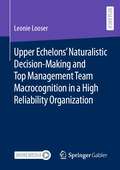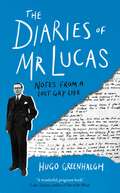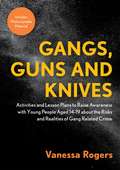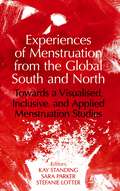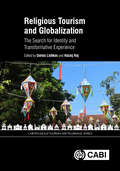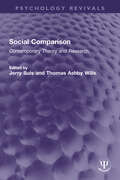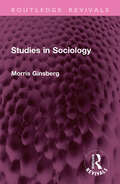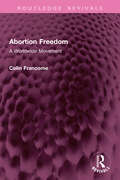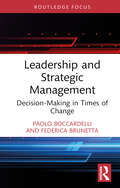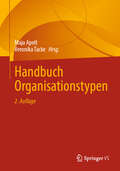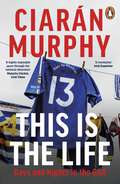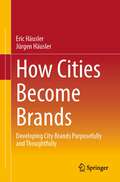- Table View
- List View
Cybercrime and Digital Deviance
by Roderick S. Graham 'Shawn K. SmithCybercrime and Digital Deviance, Second Edition, combines insights from sociology, criminology, psychology, and cybersecurity to explore cybercrimes such as hacking, identity theft, and romance scams, along with forms of digital deviance such as pornography addiction, trolling, and “canceling” people for perceived violations of norms.Other issues are explored including cybercrime investigations, nation-state cybercrime, the use of algorithms in policing, cybervictimization, and expanded discussion of the theories used to explain cybercrime. Graham and Smith conceptualize the online space as a distinct environment for social interaction, framing their work with assumptions informed by their respective work in urban sociology and spatial criminology, and offering an engaging entry point for understanding what may appear to be a technologically complex course of study. The authors apply a modified version of a typology developed by David Wall: cybertrespass, cyberfraud, cyberviolence, and cyberpornography. This typology is simple enough for students just beginning their inquiry into cybercrime, while its use of legal categories of trespassing, fraud, violent crimes against persons, and moral transgressions provides a solid foundation for deeper study. In this edition each chapter includes a new “Current Events and Critical Thinking” section, using concepts from the chapter to explore a specific event or topic like the effect of disinformation on social cohesion and politics.Taken together, Graham and Smith’s application of a digital environment and Wall’s cybercrime typology makes this an ideal upper-level text for students in sociology and criminal justice. It is also an ideal introductory text for students within the emerging disciplines of cybercrime and cybersecurity.
Celibacy, Seminary Formation, and Catholic Clerical Sexual Abuse: Exploring Sociological Connections and Alternative Clerical Training (Routledge Studies in the Sociology of Religion)
by Vivencio O. BallanoDoes the current celibate, semi-monastic, and all-male seminary formation contribute to the persistence of clerical sexual abuse in the Roman Catholic Church?Applying sociological theories on socialization, total institutions, and social resistance as the primary conceptual framework, and drawing on secondary literature, media reports, the author’s experience, interviews, and Church documents, this book argues that the Catholic Church’s institution of the celibate seminary formation as the only mode of clerical training for Catholic priests has resulted in negative unintended consequences to human formation such as the suspension of normal human socialization in society, psychosexual immaturity, and weak social control against clerical sexual abuse. The author thus contends that celibate training, while suitable for those who do live in religious or monastic communities, is inappropriate for those who are obliged to live alone and work in parishes. As such, an alternative model for diocesan clerical formation is advanced.A fresh look at the aptness – and effects – of celibate formation for diocesan clergy, this volume is the first to relate the persistence of Catholic clerical sexual abuse to celibate seminary formation, exploring the structural links between the two using sociological arguments and proposing an apprenticeship-based model of formation, which has numerous advantages as a form of clerical training. It will therefore appeal to scholars and students of religion, sociology, and theology, as well as those involved with seminary formation.
Celibacy, Seminary Formation, and Catholic Clerical Sexual Abuse: Exploring Sociological Connections and Alternative Clerical Training (Routledge Studies in the Sociology of Religion)
by Vivencio O. BallanoDoes the current celibate, semi-monastic, and all-male seminary formation contribute to the persistence of clerical sexual abuse in the Roman Catholic Church?Applying sociological theories on socialization, total institutions, and social resistance as the primary conceptual framework, and drawing on secondary literature, media reports, the author’s experience, interviews, and Church documents, this book argues that the Catholic Church’s institution of the celibate seminary formation as the only mode of clerical training for Catholic priests has resulted in negative unintended consequences to human formation such as the suspension of normal human socialization in society, psychosexual immaturity, and weak social control against clerical sexual abuse. The author thus contends that celibate training, while suitable for those who do live in religious or monastic communities, is inappropriate for those who are obliged to live alone and work in parishes. As such, an alternative model for diocesan clerical formation is advanced.A fresh look at the aptness – and effects – of celibate formation for diocesan clergy, this volume is the first to relate the persistence of Catholic clerical sexual abuse to celibate seminary formation, exploring the structural links between the two using sociological arguments and proposing an apprenticeship-based model of formation, which has numerous advantages as a form of clerical training. It will therefore appeal to scholars and students of religion, sociology, and theology, as well as those involved with seminary formation.
Hofstede Matters (ISSN)
by Sławomir J. Magala Christiane Erten Roger Matthew Bell Marie-Therese Claes Senem Yazici Atila KarabagHofstede Matters offers an updated presentation of the evolving views of academics and teachers who have worked with Hofstede’s research findings since the publication of the first edition of Culture’s Consequences in 1980. The authors reflect on their changing beliefs about the concept of cultural dimensions that led to a radical change in the way cultures were dealt with in business schools across Europe and beyond. Hofstede’s dimensions made "thinking" about culture more accessible overnight by creating a conceptual framework that teachers, students, managers, and consultants could grasp and easily apply in international comparisons. The book shows the man behind the value dimensions framework through the eyes of teachers and academics many of whom dealt with Hofstede personally. Contemporary contributors as well as younger academic fellow researchers evaluate the past paradigms and look behind the scenes to better understand the developments of the more recent ones. Jointly, they try to decide if Hofstede still helps us to overcome uncertainty when confronted with actions undertaken with different values in mind. Did he nudge us in the desirable direction? Offering a unique analysis of the strengths, criticisms, and legacy of Hofstede’s work, this book will appeal to academics and students across disciplines including cross-cultural management, critical management studies, and international management.
Hofstede Matters (ISSN)
Hofstede Matters offers an updated presentation of the evolving views of academics and teachers who have worked with Hofstede’s research findings since the publication of the first edition of Culture’s Consequences in 1980. The authors reflect on their changing beliefs about the concept of cultural dimensions that led to a radical change in the way cultures were dealt with in business schools across Europe and beyond. Hofstede’s dimensions made "thinking" about culture more accessible overnight by creating a conceptual framework that teachers, students, managers, and consultants could grasp and easily apply in international comparisons. The book shows the man behind the value dimensions framework through the eyes of teachers and academics many of whom dealt with Hofstede personally. Contemporary contributors as well as younger academic fellow researchers evaluate the past paradigms and look behind the scenes to better understand the developments of the more recent ones. Jointly, they try to decide if Hofstede still helps us to overcome uncertainty when confronted with actions undertaken with different values in mind. Did he nudge us in the desirable direction? Offering a unique analysis of the strengths, criticisms, and legacy of Hofstede’s work, this book will appeal to academics and students across disciplines including cross-cultural management, critical management studies, and international management.
The Routledge International Handbook of Boredom (Routledge International Handbooks)
This comprehensive text is a unique handbook dedicated to research on boredom. The book brings together leading contributors from across three continents and numerous fields to provide an interdisciplinary exploration of boredom, its theoretical underpinnings, its experiential properties, and the applied contexts in which it occurs.Boredom is often viewed as a mental state with little utility, though recent research suggests that it can be a powerful motivator of human behavior that shapes our actions in many ways. The book examines boredom from a range of perspectives and is comprised of three parts. Part I delves into the theoretical approaches to boredom, presenting methods for its measurement, explaining when and why boredom occurs, and scrutinizing the impact it has on our behavior. Part II focuses on the psychological and neural properties of boredom and its associations with a multitude of mental and interpersonal processes, such as self-control, mind-wandering, flow, and aggression. Part III presents boredom in practical contexts like school and work, and sheds light on its role for health-related behaviors, psychosocial well-being, and aesthetic experiences. The book concludes by summarizing the state of boredom research, identifying promising areas for future research, and providing directions for how research on boredom can be advanced. As the authoritative book on boredom, this handbook is an essential resource for students and researchers of psychology, sociology, education, sport science, and computer science.
The Routledge International Handbook of Boredom (Routledge International Handbooks)
by Maik Bieleke Wanja Wolff Corinna S. MartarelliThis comprehensive text is a unique handbook dedicated to research on boredom. The book brings together leading contributors from across three continents and numerous fields to provide an interdisciplinary exploration of boredom, its theoretical underpinnings, its experiential properties, and the applied contexts in which it occurs.Boredom is often viewed as a mental state with little utility, though recent research suggests that it can be a powerful motivator of human behavior that shapes our actions in many ways. The book examines boredom from a range of perspectives and is comprised of three parts. Part I delves into the theoretical approaches to boredom, presenting methods for its measurement, explaining when and why boredom occurs, and scrutinizing the impact it has on our behavior. Part II focuses on the psychological and neural properties of boredom and its associations with a multitude of mental and interpersonal processes, such as self-control, mind-wandering, flow, and aggression. Part III presents boredom in practical contexts like school and work, and sheds light on its role for health-related behaviors, psychosocial well-being, and aesthetic experiences. The book concludes by summarizing the state of boredom research, identifying promising areas for future research, and providing directions for how research on boredom can be advanced. As the authoritative book on boredom, this handbook is an essential resource for students and researchers of psychology, sociology, education, sport science, and computer science.
Endogenous Community Design: Community Revitalization Enabling Ecosystem for Collective Impact (International Perspectives on Social Policy, Administration, and Practice)
by Tao ChenThis book is a comprehensive exploration of endogenous community building, aiming to investigate how to create a vibrant, service-integrated, and sustainable community through collective impact approaches. It’s a guide to social innovation that combines theory and practical application. In terms of theory, it constructs concepts such as endogenous community, endogenous design system, life project platform and enabling ecosystem. In practice, it offers design methods and a toolkit for collective impact to enhance community resilience and capacity through service co-creation. This book provides readers with a systematic guide to endogenous community design, ranging from conceptual understanding and theoretical models to practical methodologies. Its aim is to build a sociotechnical system from the bottom-up to address complex issues.This book is ideal for community leaders, government officials, NGOs, urban planners, social innovators, and anyone passionate about sustainable community development.
Upper Echelons’ Naturalistic Decision-Making and Top Management Team Macrocognition in a High Reliability Organization
by Leonie LooserThe book analyzes crisis decision-making of a major German airline's operational top management team during the Covid-19 crisis. The operational top manager's relevant decision-making entity, the crisis management team, was faced with substantial time-critical decisions in volatile circumstances as well as the need to balance ambidextrous exigencies with the operation's short-term survival as well as its future viability. The author applies her ethnographic perspective and develops an analysis based on the unique combination of naturalistic decision-making, top management team research, high reliability organizations and ambidexterity as well as team diversity. The work is targeted at both management professionals, as it identifies best pratices and learnings from a polycrisis case, as well as researchers, as it makes a novel contribution to decision-making in the context of high reliability organizations.
Gangs, Guns and Knives: Activities and Lesson Plans to Raise Awareness with Young People Aged 14-19 about the Risks and Realities of Gang-Related Crime
by Vanessa RogersThis is an essential handbook for youth workers, teachers, social workers and youth justice practitioners working with young people to raise awareness about the risks and realities of gangs and gang-related crime.Each activity offers a different learning experience including quizzes, worksheets, games and interactive activities. The book explores peer pressure, loyalty and personal responsibility as well the impact that violent crime can have on individuals, family, community and wider society. It also considers the ethical and moral dilemmas of gang life, serious youth violence and crime and the potential consequences of gang membership and carrying a weapon.Written by a renowned youth worker and trainer, this essential book helps young people to separate myth from fact, build assertiveness and develop the skills to make safe choices.
Experiences of Menstruation from the Global South and North: Towards a Visualised, Inclusive, and Applied Menstruation Studies (Proceedings of the British Academy)
by KAY STANDING, SARA PARKER, AND STEFANIE LOTTERExperiences of Menstruation from the Global South and North is an edited collection that presents menstruation across the life course, from menarche to menopause. It takes a multidisciplinary perspective, based on academic research, activism, and creative work, to look at the varied and diverse lived experiences of menstruators across the Global South and North. Beyond the biological facts of menstruation, there is little we can agree upon in a global context where culture determines what menstruation is, what consequences it has for the individual, and how it is best managed. The lived experience of menstruators is inextricably entangled with the body, cultured concepts of gender, religion, economics, and of course, life itself. This volume unpacks concepts in a poly-vocal approach, highlights creative and transformative methods, and expands menstrual health and hygiene management discourses to emphasise structural issues of gender inequality, politics, and human rights.
Religious Tourism and Globalization: The Search for Identity and Transformative Experience (CABI Religious Tourism and Pilgrimage Series)
by Vitor Ambrósio Silvia Aulet Serrallonga Caglar Bideci Mujde Bideci Elzbieta Bilska-Wodecka Dr Dino Bozonelos Dr Nour Farra-Haddad Stephen F. Haller Jaffer Idris Antonietta Ivona Isilda Leitão Dimitrios Mylonopoulos Polyxeni Moira Eleanor O’Keeffe Spyridon Parthenis Donatella Privitera Ricardo Nicolas Progano Alison T. SmithIs it possible to identify the positive and negative effects of globalization on religious tourism or to estimate the transformation of the internal and external constructs of pilgrimage by these effects? In order to address these questions, this book highlights the importance of the search for identity and transformative experience during religious tourism. It also looks at how, recently, globalization has played a part in the changes of the concept of personal and social identity and the transformative experience of pilgrimage. The chapters, consisting of carefully selected case studies, analyse possible effects including the adoption of different new rituals, new pilgrims' values, changes of tradition, acceptance of technologic innovations, development of new business models, and other environmental and sociocultural changes. The book provides: · a conceptual framework for understanding the impacts of globalization; · integrated cross-disciplinary approaches; and · an insight into major religious travel practices in the age of identity challenges and worldwide transformations. It will be suitable for researchers and students of religious tourism, pilgrimage, identity tourism, as well as related subjects such as sociology, anthropology, psychology, theology, history and cultural studies.
Social Comparison: Contemporary Theory and Research (Psychology Revivals)
by Jerry Suls Thomas Ashby WillsAssessment of abilities, opinions, and overall feelings of self-worth, are commonly acknowledged to be influenced by how ones’ attributes compare with those of other people. In contemporary social psychology, this process is known as social comparison or interpersonal comparison. Originally published in 1991, this volume presents the most recent developments in this field of study at the time. As described in the chapters the theory has gone through several iterations, taken on new problems and research paradigms, and reached out to other social-psychological areas of study. Some of this research addresses questions that are logical extensions of Festinger’s theory; some consider questions that derive from entirely different ways of construing the comparison process from Festinger’s original approach. Although all questions are not settled, the work presented here shows how far the original social comparison theory has evolved and suggests where the next insights are likely to be found. Today it can be read in its historical contex
Social Comparison: Contemporary Theory and Research (Psychology Revivals)
Assessment of abilities, opinions, and overall feelings of self-worth, are commonly acknowledged to be influenced by how ones’ attributes compare with those of other people. In contemporary social psychology, this process is known as social comparison or interpersonal comparison. Originally published in 1991, this volume presents the most recent developments in this field of study at the time. As described in the chapters the theory has gone through several iterations, taken on new problems and research paradigms, and reached out to other social-psychological areas of study. Some of this research addresses questions that are logical extensions of Festinger’s theory; some consider questions that derive from entirely different ways of construing the comparison process from Festinger’s original approach. Although all questions are not settled, the work presented here shows how far the original social comparison theory has evolved and suggests where the next insights are likely to be found. Today it can be read in its historical contex
Studies in Sociology (Routledge Revivals)
by Morris GinsbergFirst published in 1932, Studies in Sociology consists of essays that fall into three groups, the first concerned with the scope and method of sociology and its relation to history and social philosophy; the second devoted to an analysis of the theory of evolution as applied to society, and to a number of problems in social psychology, such as the nature of social purpose, the place of instinct in social science, the relation between instinct and emotion, and the inheritance of mental characters; while the third group deals with the claims of Eugenics, and social classes and social mobility. This book will be of interest to students of sociology, history and philosophy.
Studies in Sociology (Routledge Revivals)
by Morris GinsbergFirst published in 1932, Studies in Sociology consists of essays that fall into three groups, the first concerned with the scope and method of sociology and its relation to history and social philosophy; the second devoted to an analysis of the theory of evolution as applied to society, and to a number of problems in social psychology, such as the nature of social purpose, the place of instinct in social science, the relation between instinct and emotion, and the inheritance of mental characters; while the third group deals with the claims of Eugenics, and social classes and social mobility. This book will be of interest to students of sociology, history and philosophy.
Abortion Freedom: A Worldwide Movement (Routledge Revivals)
by Colin FrancomeFirst published in 1984, Abortion Freedom explains the main reasons for widespread international liberalisation of abortion laws. Colin Francome points out that the birth control movement had its roots in a concern with overpopulation and that this is still a crucial issue today. A major change, however, is that whereas in the early days the socialists were often opposed to birth control they are now amongst the keenest supporters of the woman’s right to choose. The author pays particular attention to the debates in the United States, France and Italy. It is aimed primarily at students of politics, sociology and law but it has a much wider appeal to the general public as a readable explanation of the ideas and strategies of the opposing forces involved.
Abortion Freedom: A Worldwide Movement (Routledge Revivals)
by Colin FrancomeFirst published in 1984, Abortion Freedom explains the main reasons for widespread international liberalisation of abortion laws. Colin Francome points out that the birth control movement had its roots in a concern with overpopulation and that this is still a crucial issue today. A major change, however, is that whereas in the early days the socialists were often opposed to birth control they are now amongst the keenest supporters of the woman’s right to choose. The author pays particular attention to the debates in the United States, France and Italy. It is aimed primarily at students of politics, sociology and law but it has a much wider appeal to the general public as a readable explanation of the ideas and strategies of the opposing forces involved.
Leadership and Strategic Management: Decision-Making in Times of Change (ISSN)
by Paolo Boccardelli Federica BrunettaManagers are facing unprecedented complexity, volatility, and ambiguity, quickly adapting their decision-making, leadership, vision, and strategies. Megatrends and forces of change have profound implications for business models, processes, and organizational structures, calling into question current paradigms and designing future change. Additionally, unprecedented disruptions, unforecastable in their nature, have increased the need for resilience and strategic flexibility.The book aims at tackling the potential interrelations among environmental transformations, strategic decisions, and leadership to better understand the role of external and internal factors on the effectiveness of managers. The book defines “change”: its extent, nature, and characteristics. Then, it focuses on decision-making, the role of potential cognitive biases, and how the interaction with the perception of determined environmental events affects the way in which decision-makers decide to implement specific strategies. Finally, in the light of waves of strategic change, it reviews theories on leadership and transformation by looking at the role and traits of leaders.Since environmental transformations have the potential to “disrupt” not only strategies but also decision-making processes and leadership, the book provides a review on the issue and propose an integrative framework which can be useful for both scholars and managers, especially in the fields of decision-making and strategy.
Leadership and Strategic Management: Decision-Making in Times of Change (ISSN)
by Paolo Boccardelli Federica BrunettaManagers are facing unprecedented complexity, volatility, and ambiguity, quickly adapting their decision-making, leadership, vision, and strategies. Megatrends and forces of change have profound implications for business models, processes, and organizational structures, calling into question current paradigms and designing future change. Additionally, unprecedented disruptions, unforecastable in their nature, have increased the need for resilience and strategic flexibility.The book aims at tackling the potential interrelations among environmental transformations, strategic decisions, and leadership to better understand the role of external and internal factors on the effectiveness of managers. The book defines “change”: its extent, nature, and characteristics. Then, it focuses on decision-making, the role of potential cognitive biases, and how the interaction with the perception of determined environmental events affects the way in which decision-makers decide to implement specific strategies. Finally, in the light of waves of strategic change, it reviews theories on leadership and transformation by looking at the role and traits of leaders.Since environmental transformations have the potential to “disrupt” not only strategies but also decision-making processes and leadership, the book provides a review on the issue and propose an integrative framework which can be useful for both scholars and managers, especially in the fields of decision-making and strategy.
Handbuch Organisationstypen
by Maja Apelt Veronika TackeDas Handbuch legt in seiner zweiten Auflage überarbeitete und aktualisierte Darstellungen einer Vielzahl von Organisationstypen aus allen Bereichen der Gesellschaft vor und ergänzt die bisherigen Beschreibungen noch um zahlreiche weitere.
Towards Healthy Settlements: Health Implications of Residential Suburbanization in Guangzhou (Urban Sustainability)
by Tianyao ZhangThis book aims to formulate recommendations for achieving a healthy neighborhood living environment for the middle-income people in China‘s suburbs. In China, the expeditious urbanization triggers the prosperous commodity housing development, which further grows with the spatial restructuring and socioeconomic transition. Residential suburbanization is generated, accompanied with the emergence of new-middle class and the change of lifestyle. However, the health effects of suburbanization in China are overlooked. This book investigates the health performance of suburban residents and the effects of suburban living on residents‘ health. This book also examines the resident-environment transaction modes to unfold the underlying mechanism of suburban living affecting residents’ health. Suburban residents had to passively adapt to their residential environment, which is the obstacle for achieving a health-promoting environment. The institutional dynamics determining the health performance of suburban living environment were addressed with the roles of governments, developers, planners, housing managers, residents‘ committee, and ordinary residents in commodity housing development. The book found no institutional support for the creation of health-promoting environments, especially with default of governments and excessive dependence on developers for public service facilities and the absence of civil society. Thus, the book proposes that institutional innovations are necessary in term of embedding the health dimension in all sectors of the society, enlisting collaboration between public and private sectors, and between health and non-health sectors, and thus cultivating the optimization of residents-environment transactions to create health-promoting environments.
This is the Life: Days and Nights in the GAA
by Ciarán MurphyA provocative look at how grassroots GAA interacts with life in Ireland, from the wittiest Gaelic games pundit at work today The GAA is Ireland's largest civil society organisation, woven into the fabric of families and communities - and yet most books about Gaelic games focus on the greatest players and inter-county teams. This is the Life is a book about the 99%: a witty and provocative look at grassroots GAA from the most intelligent and interesting Gaelic games pundit at work today.Ciarán Murphy - of Second Captains and the Irish Times - has an unmatched feel for the timeless elements of this world and a finger on the pulse of change. He looks at the plight of rural clubs that are losing their players to the cities - and he does so not only as a journalist but as a footballer who made the same move himself. He writes about working as an assistant in the clothing shop owned by the family of Jarlath Fallon - both Ciarán's sporting hero and the local postman. And he looks a things we usually prefer not to talk about, like the role of social class in the GAA.This is the Life is a book about the places the GAA comes from, the places it can take a person, and theings that make a local club worth fighting for.
How Cities Become Brands: Developing City Brands Purposefully and Thoughtfully
by Eric Häusler Jürgen HäuslerThis book explores how the fragile and lengthy process of developing a city brand can be carefully managed. Necessary background information is explained, numerous experiences are reported, and targeted city branding is inspired in a variety of ways.The dream of every brand maker: to develop a city into a strong city brand - perhaps even a myth. The creation of myths remains a curiosity. Is it targeted, are there relevant recipes for success, and can those responsible be identified? Above all: Can the process be replicated? How do brand makers deal with the complexity of the phenomena of cities and city brands? How do they give the arduous process of creating a city brand a reasonable chance of success? How do brand makers deal with the often biting criticism from outside and the nagging self-doubt?Successful cityscapes arise from the trials and tribulations of complex and sometimes random processes. In the course of global city competition, this evolutionaryprocess is enriched with the achievements of the craft of branding. This is not a guarantee of success. Success depends on numerous prerequisites, which are discussed in detail. Finally, craft rules for good and at the same time sensitive city branding are mentioned.The translation was done with the help of artificial intelligence. A subsequent human revision was done primarily in terms of content.nal criticism and self-doubts?City images emerge from complex and random processes. In global urban competition, this process is enriched with brand making achievements. Success isn't guaranteed, depending on discussed conditions. Lastly, rules for effective city branding are outlined.nal criticism and self-doubts?City images emerge from complex and random processes. In global urban competition, this process is enriched with brand making achievements. Success isn't guaranteed, depending on discussed conditions. Lastly, rules foreffective city branding are outlined.nal criticism and self-doubts?City images emerge from complex and random processes. In global urban competition, this process is enriched with brand making achievements. Success isn't guaranteed, depending on discussed conditions. Lastly, rules for effective city branding are outlined.nal criticism and self-doubts?City images emerge from complex and random processes. In global urban competition, this process is enriched with brand making achievements. Success isn't guaranteed, depending on discussed conditions. Lastly, rules for effective city branding are outlined.nal criticism and self-doubts?City images emerge from complex and random processes. In global urban competition, this process is enriched with brand making achievements. Success isn't guaranteed, depending on discussed conditions. Lastly, rules for effective city branding are outlined.nal criticism and self-doubts?City images emergefrom complex and random processes. In global urban competition, this process is enriched with brand making achievements. Success isn't guaranteed, depending on discussed conditions. Lastly, rules for effective city branding are outlined.nal criticism and self-doubts?City images emerge from complex and random processes. In global urban competition, this process is enriched with brand making achievements. Success isn't guaranteed, depending on discussed conditions. Lastly, rules for effective city branding are outlined.City images emerge from complex and random processes. In global urban competition, this process is enriched with brand making achievements. Success isn't guaranteed, depending on discussed conditions. Lastly, rules for effective city branding are outlined.City images emerge from complex and random processes. In global urban competition, this process is enriched with brand making achievements. Success isn't guaranteed, depending on discussedconditions. Lastly, rules for effective city branding are outlined.City images emerge from
